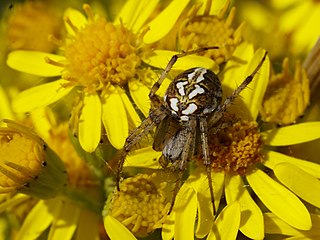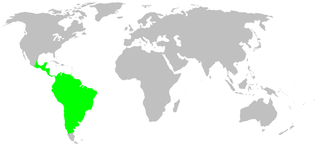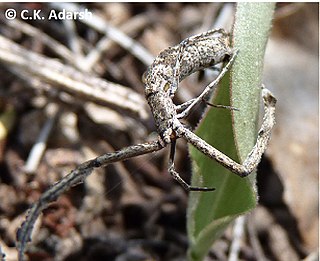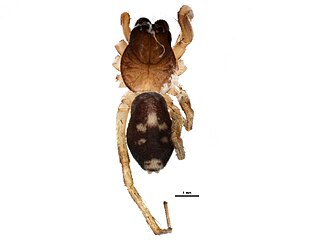
Wandering spiders (Ctenidae) are a family of spiders that includes the Brazilian wandering spiders. These spiders have a distinctive longitudinal groove on the top-rear of their oval carapace similar to those of the Amaurobiidae. They are highly defensive and venomous nocturnal hunters. Despite their notoriety for being dangerous, only a few members of Phoneutria have venom known to be hazardous to humans, but the venoms of this family are poorly known, so all larger ctenids should be treated with caution.

Cotinusa is a genus of jumping spiders that was first described by Eugène Louis Simon in 1900.

Deinopis, also known as net-casting spiders, gladiator spiders and ogre-faced spiders, is a genus of net-casting spiders that was first described by W. S. MacLeay in 1839. Its distribution is widely tropical and subtropical. They catch their prey using a specially spun "net". The name is derived from the Greek δεινός (deinos), meaning "fearful", and opis, meaning "appearance", referring to their ogre-like faces. The spelling "Dinopis" is also found, but is regarded as an "unjustified emendation".

Neoscona, known as spotted orb-weavers and barn spiders, is a genus of orb-weaver spiders (Araneidae) first described by Eugène Simon in 1895 to separate these from other araneids in the now obsolete genus Epeira. The name Neoscona was derived from the Greek νέω, meaning "spin", and σχοῐνος, meaning "reed" They have a mostly pantropical distribution and one species, Neoscona adianta, has a palearctic distribution. As of April 2019 there are eight species that can be found in the United States and Canada:

Senoculus is a genus of araneomorph spiders in the family Senoculidae, and was first described by Władysław Taczanowski in 1872. It is the only genus in the family Senoculidae.

Idiops is a genus of armored trapdoor spiders that was first described by Josef Anton Maximilian Perty in 1833. It is the type genus of the spurred trapdoor spiders, Idiopidae. Idiops is also the most species-rich genus of the family, and is found at widely separated locations in the Neotropics, Afrotropics, Indomalaya and the Middle East. Females live in tubular burrows lined with a thick layer of white silk. These typically have a D-shaped lid that fits into the entrance like a cork, and some burrows have two entrances. The lid may consist of mud, moss or lichen, which is bound below by a thick layer of silk. As in all genera of this family, the anterior lateral eyes (ALE) are situated near the clypeal margin, far in front of the remaining six eyes, which are arranged in a tight group. The males which are smaller in size, wander about or occasionally live in burrows. Like other mygalomorphs, they are relatively large and long-lived. Forest clearance and agricultural practices that loosen the soil and enhance erosion, besides soil removal for brick making have been pointed out as serious threats to some Indian species. Species ranges are poorly known – in India for instance, most species are known only from their type localities.

The Euctenizidae are a family of mygalomorph spiders. They are now considered to be more closely related to Idiopidae.

Miagrammopes is a genus of cribellate orb weavers first described by Octavius Pickard-Cambridge in 1870. These spiders have a unique shape and only four of their original eight eyes. They spin a single line of web, actively watching and jerking the line to catch their prey.
Abapeba is a genus of Central and South American corinnid sac spiders first described by A. B. Bonaldo in 2000.

Falconina is a genus of corinnid sac spiders first described by Paolo Brignoli in 1985.
Simonestus is a genus of corinnid sac spiders first described by A. B. Bonaldo in 2000.

Promyrmekiaphila is a genus of North American mygalomorph spiders in the family Euctenizidae. The genus was first described by E. Schenkel in 1950. As of May 2019 it contains only two species, both found in the United States: Promyrmekiaphila clathrata and Promyrmekiaphila winnemem.
Micrepeira is a genus of orb-weaver spiders first described by E. Schenkel in 1953.
Pozonia is a genus of orb-weaver spiders first described by E. Schenkel in 1953.
Pronoides is a genus of Asian orb-weaver spiders first described by E. Schenkel in 1936.
Wagneriana is a genus of orb-weaver spiders first described by F. O. Pickard-Cambridge in 1904.
Janetschekia is a genus of dwarf spiders that was first described by E. Schenkel in 1939. As of May 2019 it contains only two species, both found in Albania, Austria, Germany, Italy, and Switzerland: J. monodon and J. necessaria.
Macrinus is a genus of huntsman spiders that was first described by Eugène Louis Simon in 1887.









